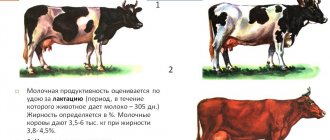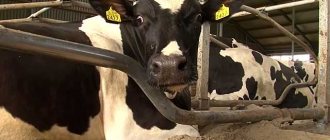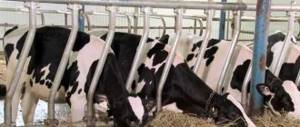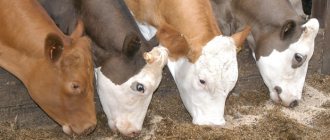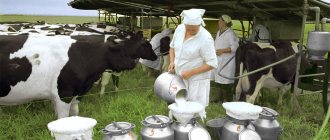Chlamydia in cattle is an infectious disease. During its development, the amniotic membranes are affected, as a result of which a chronic inflammatory process develops, premature interruptions of gestation occur in females, and dead or nonviable cubs are born. In calves whose body is affected by chlamydia, pathological processes develop in the organs of the respiratory system, in the organs of the digestive system, in the joint apparatus and organs of vision. The causative agent of the disease is chlamydia.
General information about chlamydia
Almost every farmer, while raising cows, is faced with all sorts of diseases of his pets. Some of them go away quickly, while others require a serious approach to treatment. These pathologies include chlamydia. Its clinical picture is determined by the stage and type of the disease. This disease is contagious and infectious in nature. Its main manifestations are:
- rhinitis in young animals;
- bronchial pneumonia;
- polyarthritis;
- catarrh of one of the stomach sections;
- inflammatory process in the brain or spinal cord;
- mastitis;
- inflammatory process in the cornea or conjunctiva;
- the birth of non-viable cubs.
Pathological changes
In miscarriages and calves that die immediately after birth, cyanosis of the skin is observed in the area of the nose, dewlap, forehead, oral mucosa and conjunctiva. An autopsy reveals serous edema of the skin and tissue on the neck, submandibular area, perineum, sternum and pelvis. In addition to edema, hemorrhages are noticeable in the subcutaneous tissue.
In the pericardial sac, sternum and abdominal part, the concentration of edematous fluid of a straw-yellow color with a reddish tint is mainly recorded. In the lungs of an aborted fetus or a deceased young animal, venous immobile hyperemia is diagnosed, often accompanied by edema.
Also, at autopsy, symptoms of nonspecific pneumonia or catarrhal-purulent bronchopneumonia are recorded.
Serous-mucosal inflammation is found in the stomach and narrow part of the intestine. Often in miscarriages, the mucous membrane of the thick intestine (mainly the colon) is a watery-jelly-like edema filled with a reddish-brown jelly-like mass.
Pinpoint bruises are observed in the kidneys, and venous stagnation appears on the section in the brain layer.
Did you know? The tip of a cow's nose is similar to the pad of a human finger - it has the same unique pattern. Animals can be identified with up to 100% reliability based on their nose prints.
In youngsters who died or were killed at the age of 8–20 days, at the initial stage of the disease, transformations in the heart are detected: grayish-yellow layers of fibrin are observed on the epicardium or the inner part of the pericardium.
In cows that died immediately after childbirth or miscarriage, with the genital type of chlamydia, the membrane of the uterine horns is overflowing with blood and swollen. Necrosis and hemorrhages are noticeable on the afterbirth.
In bulls, enlargement of the gonads (orchitis) and supratestinal lymph nodes is recorded, and the excretory ducts are inflamed. Hemorrhages are found in the prostate and urethral mucosa.
When dissecting animals that died from respiratory chlamydia, the following changes are found:
- the mucous membrane of the nose and throat is hyperemic, with hemorrhage and swelling;
- foci of thickening are noticeable in the lungs;
- mucous or purulent-mucous fluid is found in the bronchi;
- dilated mediastinal and bronchial lymph nodes, hemorrhages are observed on the section.
In cattle that died from an intestinal type of disease, the following is found:
- acute gastroenteritis;
- edematous mucous membrane of the abomasum;
- pinpoint hemorrhages;
- erosions and ulcers of distorted shape;
- degeneration in the kidneys, liver and spleen.
What causes it and how does it get infected?
Infection occurs after penetration of the pathogen into the body - bacteria that belong to the genus Chlamydophila. These microorganisms are distinguished by the fact that they parasitize at the cellular level. They remain viable in an unprotected environment:
- in water - up to three weeks;
- on snow – up to 17 days;
- under the snow - about a month;
- in pasteurized milk the pathogen remains viable for three weeks;
- in barns he remains capable of up to one and a half months.
Source of infection: sick animal and various types of biological fluids - sperm, blood, milk, feces. Chlamydia is transmitted in the following ways:
- contact – in the process of mating animals;
- nutritional – when eating food that contains the pathogen;
- airborne - when a healthy animal comes into contact with an infected one.
Those females that were inseminated during mating with ejaculate that contains the pathogen do not conceive and are considered infertile. If conception of the fetus does occur, its infection occurs inside the womb, and the result is spontaneous termination of gestation in the early stages or the birth of a dead or non-viable baby.
Chlamydia in animals
FEDERAL STATE EDUCATIONAL INSTITUTION OF HIGHER PROFESSIONAL EDUCATION “MOSCOW STATE ACADEMY OF VETERINARY MEDICINE AND BIOTECHNOLOGY IM. K.I. SKRYABIN"
Department of Microbiology and Immunology:
CHLAMYDIOSIS OF FARM ANIMALS.
Checked by: Muravyova
Moscow, 2008.
- Differential diagnosis
- Specific prevention
General information about the disease Chlamydiosis in farm animals is a large group of diseases, united etiologically, but mostly differing in the nature of the infectious process and the forms of its clinical manifestation. Chlamydia is characterized by abortions of breeding stock (cows, sheep, goats, pigs, horses), the birth of non-viable or weak young animals with symptoms of pneumonia, polyarthritis, enteritis, encephalomyelitis and conjunctivitis. Chlamydia belongs to zooanthroponoses with pronounced natural focality. The disease in animals is known under different names: psittacosis, ornithosis, neorickettsiosis, pararickettsiosis, sporadic encephalomyelitis, Bass encephalitis, ornithosis pneumonia, vulvovaginitis, enteritis, pneumoenteritis, ophthalmia, enzootic abortion and others . History of the study The history of the study of chlamydial infections begins in 1876, when a relationship was established between the peculiar course of human pneumonia and diseases of parrots imported from tropical countries. The role of parrots in infecting humans was finally established in 1892 during an outbreak of the disease in people who had contact with parrots imported from Buenos Aires. Morang in 1895 proposed a disease that arose from contact with parrots to be called psittacus (parrot). Later, Haagen and Maurer in 1938 established that birds not belonging to the parrot family are also reservoirs of the infectious agent and a source of infection for humans, the infection became known as ornithosis (ornix) - bird. Similarities were then found between the causative agents of psittacosis, human trachoma and lymphogranuloma inguinalis (Rake and Johnson 1942). Therefore, these pathogens were combined into one group under the code name “OLT”, i.e. ornithosis-lymphogranuloma-trachoma. In 1966, at the suggestion of researcher Page, the group of microorganisms “OLT”, which had synonymous names of bedsonia, miagavanella, pararickettsia, neorickettsia, galprovia, etc., were separated into an independent genus “ Chlamydiales ” of the family “ Chlamydiaceae ”. Thus, diseases of animals and humans caused by these microorganisms began to be called “Chlamydia.” The modern classification of chlamydia and the diseases they cause is shown in (Table 1). The table shows that the genus “ Chlamydiales ” is currently divided into two species: Chlamydia trachomatis and Chlamydia psittaci.
Table 1
| Type of microorganism | Disease caused | Source of infection |
| trachomatis | Trachoma | Human |
| psittaci | Lymphogranuloma venereum | Human |
| — “ — | Psittacosis | birds |
| — “ — | Pneumonia | cattle |
| — “ — | Vulvovaginitis | cattle |
| — “ — | Polyarthritis | calves |
| — “ — | enzootic abortion | sheep |
| — “ — | Arthritis and polyarthritis | sheep |
| — “ — | Abortion | horses and pigs |
Etiology Chlamydia is biologically related microorganisms, characterized by “ group-specific
» affinity, in contrast to other representatives of the microcosm, which determines their taxonomic position in the system of microorganisms at the level of the independent genus
Chlamydiales (Shatkin, 1979). They are gram-negative obligate intracellular parasites with a special development cycle. The main forms of the microorganism are elementary bodies - ET (infectious forms) and reticular bodies - RT (vegetative forms), as well as transitional bodies - PT. The mature morphological structure of chlamydia are elementary bodies - ETs, which have a spherical shape with a diameter of 250-350 nm, bounded by a rigid cell wall and a cytoplasmic membrane. The internal contents are represented by “galprovioplasm” containing ribosomes and an eccentrically located dense nucleotide containing DNA. The difficulties in systematizing chlamydia are due to the fact that they have properties characteristic of both viruses and bacteria. They are similar to viruses in their obligate intracellular parasitism, i.e. they reproduce only inside the cells of the macroorganism. They are similar to bacteria in that : 1. contain both types of nucleic acids DNA and RNA 2. have a cell membrane 3. contain ribosomes 4. are sensitive to some antibiotics 5. reproduce by binary fission. Chlamydia are especially similar to rickettsia. But at the same time, they differ from rickettsia in that: 1. rickettsia reproduce better in cells with a low metabolism, while chlamydia - in cells with a high level of metabolism; 2. rickettsiae have their own metabolism, since they contain all the enzymes necessary for life; 3. in rickettsia, all forms of development are infectious, and in chlamydia, only elementary bodies - ET, while transitional bodies - PT and reticular bodies - RT are non-infectious. Isolated chlamydia from different species of animals and birds differ in pathogenicity and antigenic properties. Pathogenicity . All types of agricultural animals and birds are sensitive to chlamydia. Antigenic properties . Despite the difference in origin, chlamydia contains a common stable “group-specific” antigen. This allows the isolated cultures of the pathogen to be classified as chlamydia (Kiryanov, 1990). For staining chlamydia, methods according to Romanovsky-Giemsa, Macchiavello, and Stemp are used. When fluorescent, chlamydia gives off a bright green glow. Sustainability .
They are well preserved when frozen: at minus 60°C for up to 20 months, at -20°C for up to 4-6 months. At a temperature of + 4°C up to 10 days, at +20°C up to 7 days. When exposed to high temperatures, they quickly die. Easily inactivated by traditional chemicals. Chlamydia is sensitive to tetracycline antibiotics. Chicken embryos, white mice, guinea pigs, and, to a lesser extent, rabbits, white rats and hamsters are susceptible to infection with chlamydia. Epizootological data Chlamydia has a global distribution in the world. They are registered in Europe, Asia, Africa, America and Australia (Bakulov, Yurkov, 1973). The leading factor in this widespread spread is the virtually uncontrolled reservoir of infection in nature among wild birds. 132 species from 28 families and 15 orders of the class of birds - carriers of this infectious agent have been described (Terskikh I.I., 1979). In addition to the traditionally known reservoirs of chlamydia pathogens - birds of the families Psittacidae (parrots) and Columbidae (pigeons), other birds are also of significant epizootological importance, especially birds of the aquatic or semi-aquatic complex (ducks, gulls, etc.). Circulating in nature, the causative agent of chlamydia spreads most intensively along the migration routes of wild birds in the territory of their wintering, nesting and molting areas, forming natural foci of infection (Kiryanov, 1990). The microorganism was also found in a number of arthropods - ectoparasites of birds and rodents. All major types of agricultural animals, as well as birds, dogs, and cats, are susceptible to chlamydia. The person is also sick. The source of the infectious agent is sick animals and birds. The release of the pathogen by sick animals occurs with secretions from the nasal passages, when coughing, with milk, urine, feces, and semen. Its release into the external environment is especially intense with amniotic fluid, aborted fetuses, placenta, and discharge from the genitals. Contamination of the environment by the pathogen occurs: air, floors, walls, feeders, bedding, feed, water. All of these serve as factors for transmitting the pathogen to healthy animals. The main routes of transmission of the pathogen are alimentary and aerogenic. Among mammals, the exchange of the pathogen is possible during the act of mating, through sperm during artificial insemination. Fetuses become infected in utero, at the time of birth, or through consumption of colostrum and milk. The occurrence of the disease is facilitated by unsatisfactory feeding and housing conditions, and hypothermia. In animal herds, the epizootic process is activated after calving, lambing, and abortion. Various stressful situations give impetus to the activation of the epizootic process and the manifestation of clinical pathology. Seasonality . Taking into account the characteristics of the circulation of the pathogen, the greatest risk for the occurrence of pathology exists in the spring and summer. By this time, the spring migration of birds ends, a susceptible population of young farm animals accumulates, animals are driven out to pasture, and conditions appear for unlimited contact of animals with the environment.
Pathogenesis The main gates of infection are the mucous membranes of the digestive and respiratory tracts, as well as the placenta and mucous membranes of the genital organs. Once in the body, the pathogen is initially localized in the regional lymph nodes, and then spread by lymph and blood throughout the body. The most intensive reproduction of the microbe occurs in reticuloendothelial and lymphoid cells, in the epithelium of the bronchi and bronchioles, in the alveolar epithelium, and in the organs of the reproductive system. Under the influence of a microorganism, cell destruction occurs. The pathogen, together with the contents of destroyed cells, enters the blood, causing bacteremia, toxemia, allergization of the macroorganism, and damage to various parenchymal organs. Chlamydia is characterized by long-term persistence in the body of animals, causing the possibility of disease. Immunity for chlamydia is assessed as non-sterile.
Clinical signs The disease is characterized by clinical polymorphism. Based on the predominance of damage to individual organs and systems, independent forms of infection are distinguished: in adult cattle - chlamydial abortion of cattle, chlamydial abortion of sheep. The following forms of manifestation of the disease are recorded in young animals : - chlamydial bronchopneumonia of calves; — chlamydial pneumonia of sheep and goats; — chlamydial encephalomyelitis of calves; — chlamydial enteritis of calves and sheep; — chlamydial polyarthritis of lambs and calves; - chlamydial conjunctivitis of calves and sheep. All these forms of infection can be considered under the name “Bovine Chlamydia” with a predominance of one or another symptom complex. The incubation period for spontaneous infection lasts from 2 to 3 months. Chlamydia is characterized by abortions of breeding stock at 7-9 months of pregnancy, but can also occur at the 4th month. The disease begins suddenly, and cows before abortion do not show any special clinical signs, only body temperature rises to 40.5°C. Sometimes there is progressive exhaustion of animals. According to (Schoop and Kauker, 1956), animals get sick for 6 months. The disease is characterized mainly by a decrease in milk production. A significant proportion of aborted animals experience retention of the placenta, develop metritis, vaginitis and, finally, infertility may occur. The French scientist Mage (1976) believes that in 20 cases out of 100, abortions in cows are caused by chlamydia. 2-7% of cows give birth to dead fetuses. The percentage of aborted animals in dysfunctional herds can reach up to 70, especially among first-calf heifers and newly introduced cows (Mekercher et al, 1969). Cows experience mastitis, changes in the properties of milk, or complete cessation of lactation (agalactia). In breeding bulls, the infection occurs asymptomatically or with mild urethritis, less commonly orchitis. In calves, chlamydia is characterized by enteritis, bronchopneumonia, keratoconjunctivitis, sometimes polyarthritis and dysfunction of the central nervous system. These signs may not develop simultaneously. At the beginning, enteritis appears in newborn calves, accompanied by an increase in body temperature, depression, lack or decrease of appetite, retention, as well as involuntary excretion of feces mixed with mucus and sometimes blood. Phenomena of dehydration and toxicosis of the body are noted. In some cases, enteritis occurs in a mild form, with only a short-term increase in body temperature, and sometimes asymptomatic. At 3-10 days of age, some calves show signs of damage to the joints (mainly the carpals): swelling, increased local temperature, pain, lameness. Sick animals try to lie down more. Many people have increased body temperature, heart rate and breathing. At 10-20 days of age, calves often experience rhinitis with mucous or mucopurulent discharge from the nasal passages, breathing becomes difficult, and wheezing is heard. In some calves, eye lesions are detected - at the beginning, symptoms of acute catarrh of the conjunctiva are observed, often one-sided: hyperemia, lacrimation, gluing of the eyelids. After 5-6 days, keratitis develops - clouding of the cornea, vascularization. Sometimes ulcers form on the cornea and the contents of the anterior chamber of the eye leak out. In calves older than 20-30 days of age, signs of bronchopneumonia predominate. Body temperature rises to 41.5°C, cough, rapid breathing, stiffness of movements, wide stance of the limbs, especially the hind limbs, shortness of breath. Serous or serous-mucous discharge is discharged from the nasal openings and eyes. Wheezing can be heard in the lungs; upon percussion, areas of dullness are heard, in particular in the diaphragmatic, cardiac and especially in the apical lobes of the lungs. Some animals may experience encephalitis: convulsions, circular movements. Mortality may be higher than 20%. The largest number of calves die at the age of 1-6 months (from bronchopneumonia). It is important to note that in different farms chlamydia occurs in a unique way: abortions can occur in 5 to 30, sometimes up to 70% of wombs. In calves on some farms, chlamydia manifests itself mainly as gastroenteritis and bronchopneumonia, and arthritis only in isolated cases; in others all the signs appear almost equally; thirdly, mainly bronchopneumonia and keratoconjunctivitis. It has been noted that in calves born in the summer, joint damage is observed very rarely. In general, in Siberia, in terms of the frequency of clinical signs, enteritis takes 1st place (up to 90%), respiratory pathology is in second place (30-60%), keratoconjunctivitis is in third (up to 30%), and then polyarthritis (10-16%). Encephalitis is rare. If chlamydia is associated with adenoviral, parainfluenza or mycoplasma infection, the severity of the disease increases and mortality increases.
Pathoanatomical changes Macroscopic changes in the genital organs of cows are not typical. After an abortion, catarrhal endometritis, cervicitis and vaginitis are discovered with numerous hemorrhages on the mucous membrane. Hemorrhages are also found in regional lymph nodes. Purulent-catarrhal, fibrinous or ichorous exudate accumulates in the cavity. The membranes are swollen, and in places the intercotyledon chorion is gelatinously infiltrated. The cotyledons contain many small necrotic foci of grayish-yellow color. With chlamydia, characteristic pathological changes are found in the organs of aborted fetuses, which can be used as a diagnostic indicator. The fruits themselves are usually well developed, with pronounced hair. Noteworthy is the swelling of the subcutaneous tissue and the accumulation of large amounts of fluid in the abdominal and thoracic cavities. Multiple pinpoint hemorrhages are often found on the mucous membrane of the larynx, trachea, tongue, eyes, abomasum, on the costal and pulmonary pleura, endo- and epicardium, thymus and in the portal lymph nodes. The liver is enlarged, brittle, unevenly colored. Kidneys with symptoms of severe protein dystrophy. The mucous membrane of the small and large intestines is swollen, hyperemic, and dotted with hemorrhages. Regional lymph nodes are enlarged and hemorrhagically infiltrated. In dead calves, the main changes are found in the lungs . The apical and middle lobes of the lungs are focally compacted, their interlobular layers are expanded and gray in color. The liver has an uneven red-yellow color, the pattern of the organ is smoothed. The mucous membranes of the abomasum and intestines are reddened, covered with mucus, and in some places contain hemorrhages, erosions and ulcers. The spleen and lymph nodes are enlarged, while the bronchial nodes can reach the size of a chicken egg. Liver dystrophy is often observed .
Diagnosis Making a diagnosis of chlamydia is difficult. This is primarily due to the lack of knowledge of the disease, insufficiently developed diagnostic methods, as well as the variety of forms of manifestation of the disease and the absence of pathological signs inherent only to chlamydia. As a result, it is not uncommon for chlamydia to go undiagnosed. Typically, the need to test for chlamydia arises after bacterial infections have been ruled out. The diagnosis of chlamydia can be made on the basis of a complex of clinical, microscopic, virological, serological studies, taking into account the results of a pathological autopsy. But the basis is the isolation of chlamydia culture. When making a diagnosis, the epizootological features of chlamydia should be taken into account: the enzootic nature of outbreaks, age-related susceptibility, stationarity of the disease on farms, the influence of unfavorable factors that reduce the resistance of animals. This takes into account: - low percentage of calves per 100 cows - number of abortions and stillbirths - retention of placenta, endometritis and vaginitis - in young animals - enteritis, bronchopneumonia, arthritis and conjunctivitis. The following is sent to the laboratory for testing for chlamydia : - material from aborted animals (pieces of placenta, vaginal mucus); — aborted whole fetuses or parenchymal organs from them; — blood serum in the amount of 2-3 ml from animals that have aborted and are suspicious for the disease. The material is collected no later than 2 hours after the abortion into sterile, hermetically sealed vials. Vials with the material are placed in a thermos with ice, and the aborted fetuses are placed in a moisture-proof container and delivered to the laboratory on the same day, but no later than 24 hours after the abortion, in compliance with measures to prevent the spread of infection. Microscopic method . Imprint smears are prepared from the delivered material for light microscopy and stained using the Stemp or Romanovsky-Giemsa method. Stained and dried smears are viewed under immersion microscope. The results of microscopy are considered positive when prints of chlamydia are detected in smears, which are round in shape and located separately or in clusters inside and outside the cells. When stained according to Stemp, chlamydia are bright red against a greenish background of cells. When stained according to Romanovsky-Giemsa, chlamydia are dark purple against a blue background of cells. In addition to light microscopy, the method of immunofluorescence is successfully used. Virological method . Isolation of chlamydia is carried out on chicken embryos or laboratory animals. To infect chicken embryos, it is necessary to take as many different tissues and tissues from the corpse as possible: affected areas of the placenta, lungs, spleen, liver, brain, lymph nodes, peritoneal and pleural fluids of the fetus. In case of specific death of chicken embryos on days 5-10 or white mice on days 5-7 after infection, fingerprint smears are prepared from the yolk sacs of embryos or from the lungs, spleen and liver of mice. The preparations are stained according to Stemp and examined under a microscope. When pregnant guinea pigs are infected subcutaneously, abortions occur 10-20 days after injection of the material. chlamydia is found in peritoneal exudate and in the placenta. Serological method . Paired blood serum samples are studied in RSC and RDSC. Differential diagnosis In adult animals, chlamydia is clinically similar to brucellosis, campylobacteriosis, RTI, trichomoniasis and listeriosis. In young animals, it is necessary to differentiate from a number of viral (PG-3, adenoviral infection, viral diarrhea, RTI) and bacterial infections, such as pasteurellosis, salmonellosis, streptococcosis, diplococcosis, etc.). Listeriosis is clinically characterized by unilateral facial paralysis; at autopsy, an inflammatory reaction in the body cavities is not detected. With brucellosis, there is a high barrenness of the livestock and more frequent retention of placenta, the development of metritis and endometritis. Brucellosis is excluded based on serological and bacteriological studies. Campylobacteriosis is a characteristic feature of the presence of a pathological dark brown discharge from the uterus after an abortion, in which the causative agent of the disease is found. Leptospirosis - characteristic signs are yellowness of the mucous membranes, hematuria and hemoglobinuria. Detection of leptospira in urine and agglutinins in blood. With viral diarrhea , erosions and ulcers occur on the nasal mirror, in the oral cavity, esophagus, as well as in the rumen and in the folds of the book. The results of pathological examination, bacteriological and parasitological analyzes and serological diagnosis make it possible to clearly differentiate these diseases.
Treatment Various drugs have been tested to treat chlamydia. It turned out that penicillin, polymyxin, kanamycin, and streptomycin, which are effective against bacterial diseases, are not as effective for chlamydia as sulfonamides. The therapeutic effect for chlamydia is provided by tetracycline drugs, however, the pathogen persists in the organs of clinically recovered animals, and relapses may occur. Taking this into account, calves obtained from a dysfunctional herd must be subjected to preventive treatment. For this purpose, a group of convalescent donors is selected from among the cows that have recovered (animals whose blood serum contains antibodies in titers of 1:20 or higher). Blood serum is obtained by settling. The resulting convalescent serum against chlamydia is administered to calves at a dose of 0.7 ml per kg of animal weight twice at 3 and 10 days of age. In order to enhance therapeutic effectiveness, sick calves should add dibiomycin to the serum at the rate of 10 thousand units per kg of animal weight. If it is not possible to produce convalescent serum, oxytetracycline or tetracycline is used to treat calves. Treatment consists of double injections on the first day at a dose of 5000 units/kg of animal weight. After 2-3 days, the symptoms of general intoxication decrease and body temperature decreases. However, given that inflammatory processes in the lungs normalize slowly, treatment should be continued for 8-9 days. In a dysfunctional herd, cows and heifers are injected subcutaneously 4-6 weeks before calving with dibiomycin in the form of a 10% trivitamin suspension at the rate of 10 thousand units/kg of animal weight, 4-6 weeks before calving, and re-injected after 10 days. In the absence of dibiomycin, the course is carried out with other antibiotics of the tetracycline group in doses recommended by guidelines for the use of antibiotics in veterinary medicine. Producing bulls suspected of being infected with chlamydia (in breeding farms, herds) are also given the above-described course of tetracycline antibiotics. Currently recommended for the treatment of chlamydia are dibiomycin, tilan, farmazin, and iodotriethylene glycol. For the treatment of calves with bronchopneumonia, it is better to use the aerosol method (Goloviznin Yu.V., Mitrofanov P.M.) The above drugs can be used as chemotherapeutic agents. The complex also includes immune serums and drugs that stimulate nonspecific resistance of the animal body. Treatment duration is 60 minutes. The course of treatment is 6-8 sessions.
Prevention and control measures Specific prevention Currently, the “Emulsified vaccine against chlamydia abortion of sheep” produced by the Sumy Biofactory, Ukraine, is used for immunization of animals, which is also used for other animals. Studies have shown that it protects 96-98% of vaccinated animals. Immunity for up to a year. In Russia, the “Inactivated cultural vaccine against chlamydia in cattle” is produced in Novocherkassk. It is administered 3 times subcutaneously in a dose of 5 ml. Immunity 6 months. The “Inactivated emulsified vaccine against chlamydia” in Hungary is also widely used. The polyvalent vaccine “PLAH” has also proven itself positively against: parvovirus infection leptospirosis, b. Aujesca and chlamydia Control measures For chlamydial infections of cattle, pigs, horses, under the conditions of restrictions in a dysfunctional farm (farm, flock), the following measures are carried out: - prohibit the entry (import) and exit (export) of cattle, pigs, horses, export of feed, fodder that came into contact with sick animals; - prohibit the movement of animals; - do not allow raw products obtained from sick animals to be fed to omnivorous and carnivorous animals; — prohibit access to livestock premises for persons not involved in the feeding, care and maintenance of animals; - free mating of cows, heifers, heifers, sheep, pigs and horses is prohibited; - conduct a daily clinical examination of animals with mandatory thermometry, sick animals are placed in an isolation ward for 30 days and treated using tetracycline antibiotics; — pens for group housing and other premises where sick animals are located must be cleaned and disinfected daily with a 2% solution of caustic soda or a 5% solution of formaldehyde. Manure, leftover feed, bedding, etc. stored in separate piles for biothermal disinfection; — placentas and fetuses of aborted cows, mares and sows, the corpses of dead animals are stored in liquid-tight boxes and, after taking the necessary pathological material for laboratory research, they are disinfected or destroyed; — in dysfunctional farms, newborn calves, foals and piglets are kept isolated from sick animals and are served by separate personnel. A farm (farm) is considered free from chlamydial infections provided that: - there have been no cases of sick animals with clinical and epizootological data and autopsy findings characteristic of these diseases for 3 years; — absence of specific antibodies in diagnostic titers (1:10 and above) when examining animal blood sera in RSC or RDSC.
Classification and clinical picture
Depending on the form of development of the disease, its symptoms are determined. There are only five forms of the disease. Each of them has its own characteristics and characteristics of its course. What all species have in common is that symptoms appear within two weeks of infection. Let's learn about the forms and symptoms in more detail.
Respiratory view
If the pathogen has entered the body of cattle through the epithelium of the respiratory tract, a respiratory form of the disease develops. The distinctive symptoms of this pathological process include:
- temperature increases to 40 degrees, hyperthermia persists for several days;
- serous discharge, after a few days it becomes mucopurulent;
- coughing attacks;
- rhinorrhea;
- swelling and hyperemia of the nasal passages;
- increased heart rate and breathing;
- development of conjunctivitis, swelling of the upper and lower eyelids.
Important! With the development of this form of the disease, death in the absence of timely assistance occurs in every fourth animal in the livestock.
Intestinal view
This form of the disease develops after an animal eats food that contains biological fluids of diseased individuals. The main symptoms of the development of the disease include:
- febrile hyperthermia;
- intestinal disorder, streaks of blood and mucus are present in the stool;
- loss of appetite;
- hyperemia of the surface of the oral mucosa;
- weakness;
- increased heart rate and breathing;
- animal depression.
In some cases, microdamages and ulcers are present on the oral mucosa. The main symptom is digestive upset.
Genital view
Infection of females occurs during artificial insemination or during mating if the male is a carrier of the pathogen. The key manifestations of this form of the disease are:
- the release of the placenta is delayed, even if labor was successful;
- development of mastitis;
- spontaneous interruption of gestation at various stages;
- the birth of a dead baby;
- endometriosis and endometritis;
- impossibility of conceiving offspring.
When an outbreak of disease occurs in a herd, almost half of the individuals become infected. Young animals with this form die in a ratio of 50%.
Encephalitic appearance
With this form of development, the pathogen parasitizes the cells of the nervous system and the tissues of the musculoskeletal system. This is manifested by the following symptoms:
- muscle cramps;
- tremor of the fore and hind limbs and head;
- violation of coordination in space.
With serious damage to the nervous system and in the absence of proper treatment, death occurs in almost every sick animal.
Conjunctival view
The development of this form of the disease is characterized by the appearance of conjunctivitis. This is accompanied by the following clinical manifestations:
- discharge of various types from the lacrimal sac and conjunctiva;
- hyperemia and swelling of the eyelids;
- the appearance of photophobia;
- fine-grained growths on the mucous membrane.
The inflammatory process spreads to the corneal tissue, resulting in keratitis and small ulcerations.
What is bovine chlamydia?
The disease is widespread throughout Russia. Chlamydia parasites affect all breeds of cattle. Animals get sick at any age, at any time of the year.
Chlamydia mainly lives in the gastrointestinal tract and genitals, multiplies in the lymphoid organs, and quickly spreads to the liver, kidneys, spleen, and lungs. The development of the disease affects the immune system. Adults are susceptible to frequent infections, while young animals are severely retarded in development. Chlamydia infection is accompanied by infection by viruses, bacteria, and mycoplasma.
Chlamydia has many forms depending on the organs and tissues affected. Mortality depends on the form of the disease. In particular, with the respiratory form it is up to 25%, with the genital form - up to 60%.
Diagnostic measures
In order for a doctor to make a diagnosis such as chlamydia, it is important to contact a veterinarian when the first signs of the disease appear. A timely visit to the doctor will make it possible to preserve the life and health of the cow population. The veterinarian collects biological materials and sends them and blood for further laboratory testing. In a laboratory setting, smears are stained with special substances - reagents. Next, several diagnostic studies are carried out at once.
The most reliable method is serological testing. Thanks to this procedure, antibodies and antigens to the causative agent of the disease can be detected in the serum of the blood fluid. In females whose gestation has been interrupted, antibody levels reach 1 in 64. This confirms the presence of chlamydia in the body. It is with the help of laboratory diagnostics that a reliable diagnosis can be made; the veterinarian will be able to exclude other diseases with similar symptoms, for example, leptospirosis, rhinotracheitis, brucellosis, salmonellosis.
Diagnosis of chlamydia in cattle
To diagnose chlamydia in farm animals, epizootological data, conclusions about pathological changes, and the results of clinical observations are used. Chlamydia is also detected through laboratory tests, for which blood, feces, and swabs from the nasal mucosa and conjunctiva are taken for analysis from infected cattle.
Washings from the nasal mucosa and conjunctiva
For postmortem examinations, parts of all major internal organs are taken from dead livestock, and in abortive processes, the placenta, vaginal mucus, abomasal contents, and samples of the liver, spleen, and kidneys are examined. To detect chlamydia in breeding bulls, laboratory tests are performed on sperm, ejaculate, and also analyzes of swabs from the preputial sac.
The diagnosis is made according to laboratory tests in the following cases:
- when the pathogen Chlamydia psittaci is isolated in selected tissues and fluids;
- when Chlamydia psittaci is detected in the selected tests and the results of the blood serum analysis are positive;
- with an increase in antibody titer in the blood serum of aborted cattle.
When issuing a diagnosis, it is worth distinguishing the respiratory and intestinal type of disease from rhinotracheitis of infectious origin, mycoplasmosis, salmonellosis, adenoviral disease and colibacillosis. The encephalitic form should be differentiated from diseases such as listeriosis, rabies, and Aujeszky's disease.
Pathological studies reveal an enlarged granular liver, specific foci of inflammation in the myocardium, and inflammatory processes in the animal’s kidneys. Also, animal corpses may show signs of gastroenterocolitis, pleurisy, pneumonia, necrosis of cartilage in joints, hemorrhages and accumulation of grayish-yellow fluid. All these signs are most characteristic of cattle fetuses aborted at 7-9 months. At earlier stages of abortion, the internal organs of the fetus do not have visible lesions, with the exception of accumulations of reddish fluid in the abdominal and pleural area and reddish subcutaneous edema.
Changes that are detected by the pathologist
With the development of an acute form of chlamydia, certain traces remain on the anatomical structure, in particular, they are found when examining biological material after an abortion. The following signs are found on such fruits:
- hyperemia of subcutaneous tissue;
- extensive hemorrhages in the tissues of the pleura, endocardium, epicardium, kidneys, tissues of the lymphatic system;
- the presence of a hemorrhagic transudant in the abdominal cavity;
- fatty degeneration in the liver.
During the autopsy of dead animals, hyperemia of the mucous membrane of the nasal and oral cavities, swelling and ulceration of the tissues are detected. There are compactions in the lungs, mucous exudate and enlarged lymph nodes are present in the bronchial tree.
With the development of the enteric type of disease, which is diagnosed in stillborn babies, catarrhal gastroenteritis is present, the lymph nodes are inflamed, and there are pinpoint hemorrhages. The tissues of the liver, kidneys and spleen are modified. After an examination has been carried out and chlamydia has been diagnosed, it is imperative to dispose of the aborted material or dead individuals. Because even after death occurs, they are sources of infection and are dangerous for other members of the livestock.
In those cows that have suffered from a miscarriage or unsuccessful delivery, when the genital form of the disease develops, signs such as swelling of the uterine lining and overcrowding with blood fluid are found. Necrosis and hemorrhages are observed on the surface of the placenta. In bulls, enlarged lymph nodes, orchitis, and inflammation of the excretory ducts are recorded. Extensive hemorrhages are recorded in the tissues of the prostate gland and in the urethra.
Symptoms of chlamydia in cows
- Intestinal form: diarrhea, lack of appetite, depression, weakness, temperature 40-40.5 ° C, hyperemic oral mucosa with ulcers.
- Genital form: retained placenta, infertility, endometritis, metritis, constant abortions.
- Respiratory form: cough, fever, conjunctivitis, swelling of the nasal mucosa, short-term increase in temperature up to 41 ° C, serous discharge from the nose.
- Encephalitic form: damage to the nervous system, trembling of the limbs, head, disturbances in gait, coordination, muscle cramps. The most severe form, in which mortality reaches 100%.
- The disease can manifest itself in the form of gastroenteritis, rhinitis, polyarthritis, mastitis, bronchopneumonia, conjunctivitis (especially in calves).
Therapeutic measures
Treatment of chlamydia in cattle is carried out using antibacterial drugs. But here you need to take into account that standard medicines and drugs that belong to the category of sulfonamides will be ineffective in this case. Therefore, the doctor often prescribes drugs that belong to the tetracycline group.
Important! Young animals are treated with oxytetracycline. It is given along with food or injected in the morning and evening. Dosages, dosage regimen and duration of use are prescribed by a veterinarian.
Then, one injection per day is administered for nine days. In some cases, convalescent serum is administered to calves. An additional drug is dibiomycin. Chlamydia pneumonia is treated with aerosol medications, which are sprayed on the surface of the mucous membranes of sick individuals. At the same time, drugs are prescribed to increase the resistance of the sick animal’s body, pro-immune serums. Such an integrated approach to treatment will help increase the effectiveness of therapy several times.
Therapy for sick bulls is carried out according to the same algorithm as therapy for females and calves. Tetracycline antibacterial agents are also used, dosages are prescribed by a veterinarian.
Features of vaccination
A serious disease such as chlamydia cannot always be cured quickly. Sometimes mass deaths occur among sick animals. Therefore, to minimize the death of your pets, it is recommended to perform timely vaccinations. This is a standard method that will provide protection against the disease. The vaccine is administered into the animal's body once, using specialized medications.
After this procedure, the animal’s body is reliably protected from infection and the development of the disease for one year. Vaccination is allowed only after a doctor confirms the health of the animal. And if sick individuals are discovered, they should be isolated from other animals as quickly as possible, and then treatment should begin as soon as possible.
Preventive actions
To prevent the development of chlamydia in livestock, it is very important to follow simple preventive measures:
- Healthy animals should not be grazed in places where quarantine has been established; contact of cows with representatives of other farms should especially be avoided;
- You cannot feed healthy livestock with leftover feed from infected animals;
- it is very important to regularly examine all animals, periodically conduct preventive examinations, examine the taken biomaterial, since the earlier the disease is detected, the easier it will be to prevent the death of animals in the herd;
- it is important to systematically disinfect barns, including feeders, stalls, drinking bowls with which animals come into contact, such measures are carried out according to a certain scheme, which is established by the sanitary services of specific regions;
- You cannot import or export animals and their waste products from those farms where outbreaks of chlamydia have been recorded;
- You cannot use untested sources for watering animals, avoid contact with snow or random bodies of water, since they may contain the pathogen for several weeks;
- for those animals that are just entering the herd, it is necessary to quarantine for one month;
- Twice a year it is necessary to carry out examination and laboratory tests of breeding bulls to exclude the presence of antibodies to chlamydia.
Chlamydia is a fairly serious pathological process. It can affect even the largest livestock populations, but it is quite difficult to combat, especially on those farms where a large number of livestock are registered. If you follow simple measures to prevent an outbreak of the disease, you can minimize the risk of its development.
Having noticed the first signs of a dangerous disease in your pets, you need to contact a veterinarian as soon as possible, since only a specialist can correctly establish a diagnosis and prescribe timely therapeutic measures.
Preventive measures
For preventive purposes, livestock are immunized with specialized drugs. The vaccine is administered once and provides a high degree of protection against chlamydia throughout the year. Only healthy individuals undergo the procedure! When an infectious disease is detected on farms, it is necessary to carry out urgent isolation of unhealthy animals and a course of drug therapy.
To prevent infection, grazing of livestock from a quarantined farm together with animals from other farms is prohibited. Feeding healthy animals with products left over from infected livestock is contraindicated.
If infection is suspected, livestock are examined every day, and biological material is collected for testing. The entire premises in which animals are kept must be disinfected. The timing of procedures for preventive purposes is established by sanitary services. The agricultural law prescribes the imposition of restrictions on export and import outside farms when chlamydia is detected in cattle.

